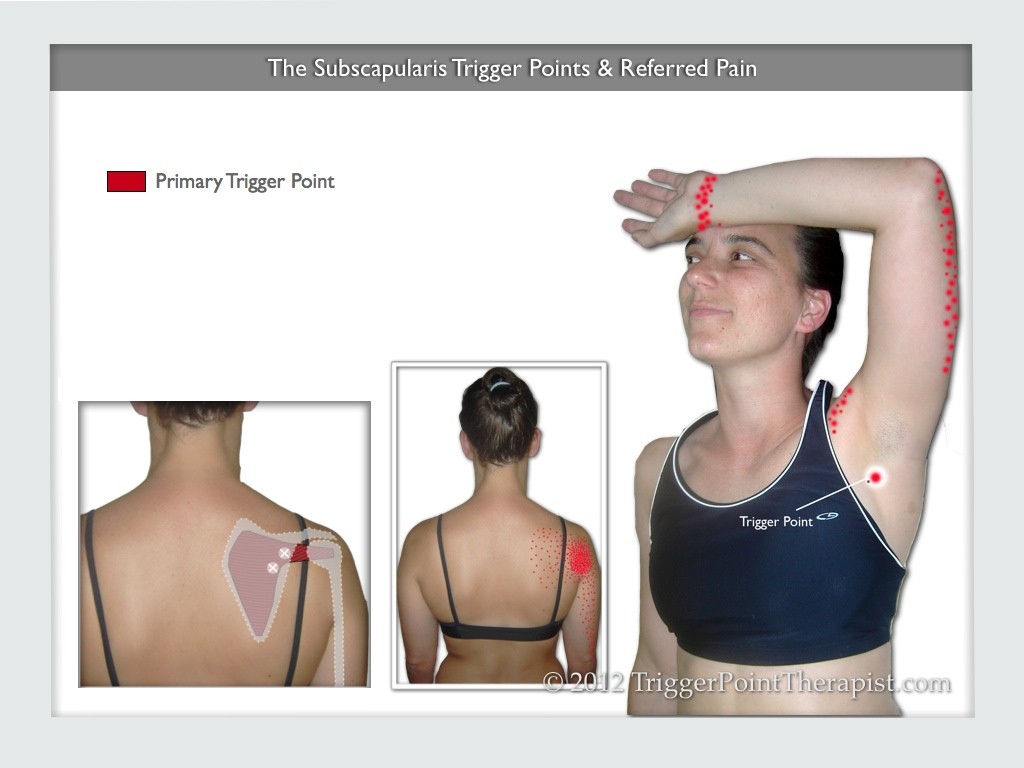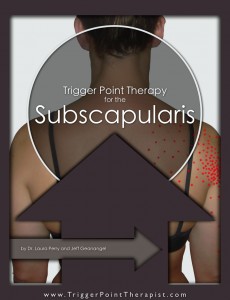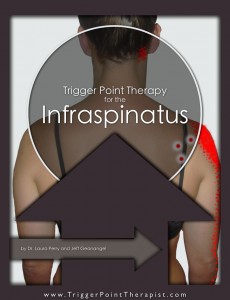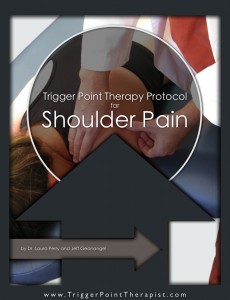I have seen more than my share of frozen shoulder complaints over the years, and though each case of frozen shoulder is always a little bit different, they all have one thing in common; subscapularis trigger points. A little understanding of these trigger points goes a long way towards “thawing out” a frozen shoulder.
The Subscapularis Muscle
Anatomy & Biomechanics: As its name suggests, the subscapularis muscle is found underneath the scapula or shoulder blade, sandwiched between it and the ribcage. The muscle extends laterally to attach on the front of humeral head in the shoulder joint. Contraction of the subscapularis rotates the arm inwardly and also pulls it towards the body (adduction). As one of the rotator cuff muscles, the subscapularis acts to hold the glenohumeral joint together during movements of the shoulder joint, specifically countering the tendency of the humeral head to slip upward during abduction movements.
Synergistic Muscles: The subscapularis muscle is assisted by the teres major and pectoralis major muscles during medial rotation of the arm, and by the other rotator cuff muscles during stabilization of the glenohumeral joint.
Subscapularis Trigger Points and Referred Pain
This subscapularis can harbor up to three trigger points, with the two most common occurring near the outside edge of the muscle. Luckily, the trigger point on the inside edge of the muscle (not shown below) is much less common, because it is nearly impossible to contact by palpation and release manually.
Referred pain from trigger points in the subscapularis muscle concentrates in the posterior shoulder region, with spillover into shoulder blade region and down the back of the upper arm. A unique “band” of referred pain around the wrist may occur as well. Typically the client is aware of this wrist pain, but does not think it is related to their shoulder pain.
What Causes Subscapularis Trigger Points?
As discussed in Causes of Trigger Points, most trigger points are activated by some form of muscular overload. Some examples of muscular overload specific to the subscapularis muscle include:
- Bracing a fall by extending the arm out at shoulder level, as to grab for a railing, countertop, or another person.
- Repetitive use injuries in sports, such as swimming, throwing a baseball, or playing tennis.
- Long periods of arm immobilization, such as when wearing a cast on the arm
- Sleeping on the side, with the affected shoulder down and the arm pushed forward across the body.
Subscapularis Symptoms & Disorders
The following symptoms and disorders are associated with trigger point activity in the subscapularis muscle:
- Severe Pain in the Posterior Shoulder Region: This pain may occur during shoulder movement or at rest, and is generally felt as being deep within the joint.
- Unable to Lift Arm Past 45 Degrees: A client with chronic subscapularis trigger points will be unable to abduct arm (lift it to the side) past about 45 degrees. In the early stages, the client may be able to lift their arm, but will be unable to reach backwards with it.
- Unable to Reach Across The Body: Clients will complain of being unable to reach across the front of the body to their other armpit, as this will stretch the muscle and aggravate its trigger points.
- Frozen Shoulder or Adhesive Capsulitis: The term frozen shoulder is an overused label for a vague condition that frequently has no objective evidence of injury or disease supporting it. The symptoms associated with subscapularis trigger points are nearly identical to those attributed to frozen shoulder (shoulder pain coupled with limited shoulder joint movement), and are easily diagnosed and treated. The pain associated with adhesive capsulitis is generally less severe than the pain from subscapularis trigger point activity, and both conditions tend to coexist and reinforce each other.
Treatment Advice for the Subscapularis Trigger Points
In the acute stage of frozen shoulder, subscapularis trigger points play the dominant role. As this condition progresses, pectoralis trigger points will often develop, followed by trigger point activity in the teres major muscle. In clients that have been diagnosed with Adhesive Capsulitis, the therapist should keep an eye out for trigger points in the supraspinatus and deltoid muscles as well. For complete instructions on how to locate and release these trigger points you can purchase the Trigger Point Therapy for Subscapularis Video.
Click on the image below to view an excerpt from the Subscapularis Trigger Points video on YouTube:
Related Articles:
- Shoulder Pain Trigger Points: The Multi-Headed Myofascial Pain Monster
- Infraspinatus Trigger Points: The Magicians of Shoulder Pain
- Supraspinatus Trigger Points: Treating the “Stubborn-atus” Trigger Points
- The Deltoid Trigger Points: What You See Is What You Get
Related Instructional Videos:





